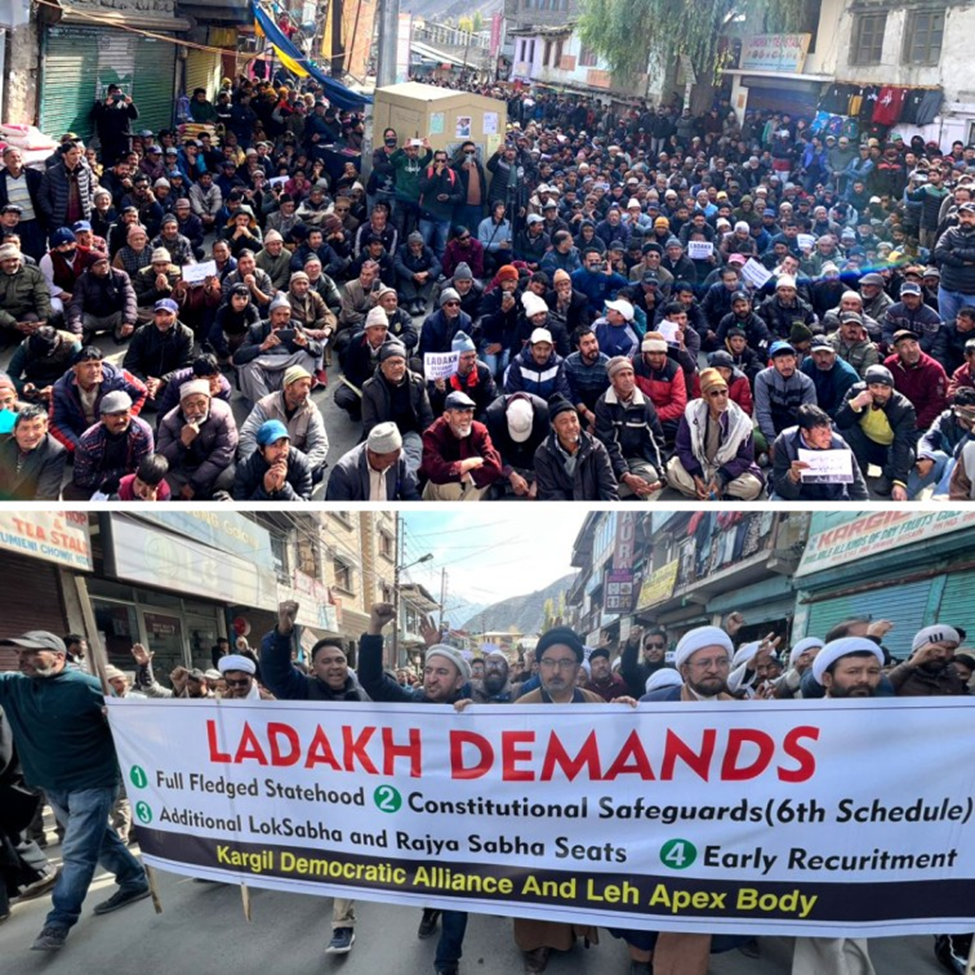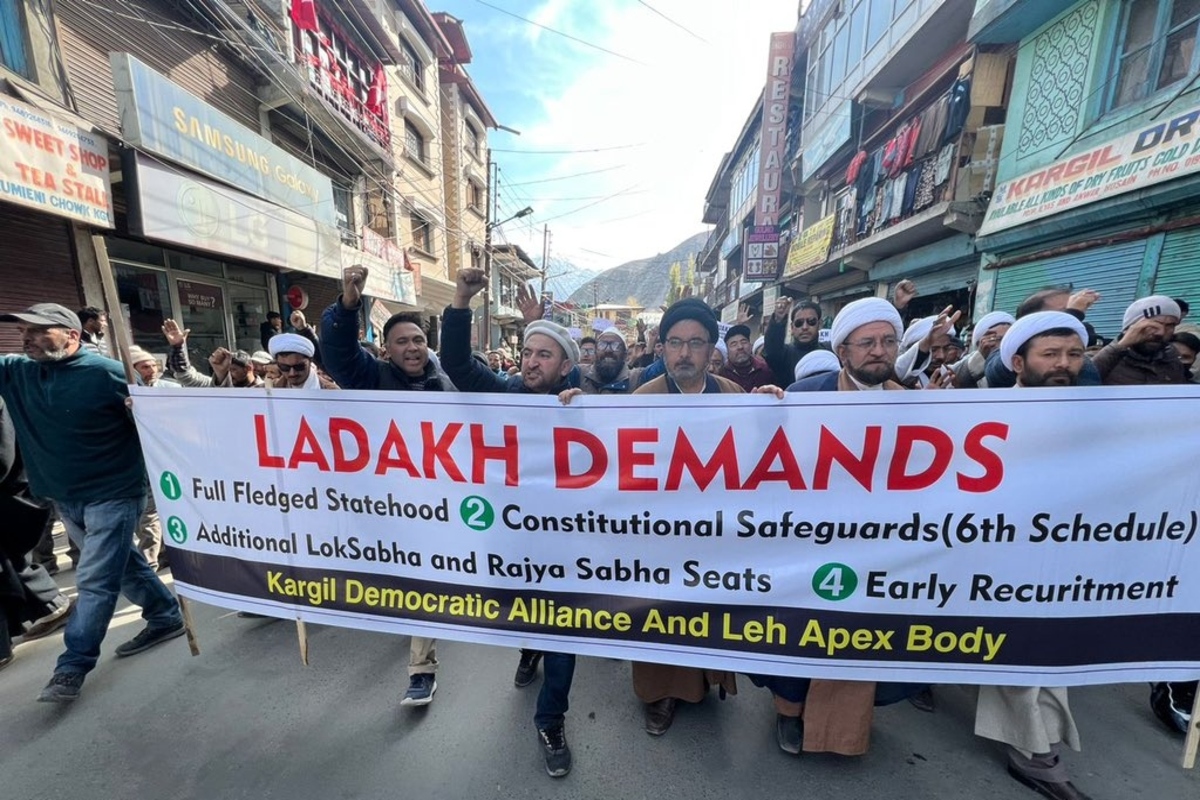Context:
The serene landscapes of Ladakh, nestled amidst the towering peaks of the Himalayas, have recently been embroiled in unrest and turmoil. What initially seemed like a step towards development and autonomy has gradually transformed into a saga of caution, anger, and protest. Ladakh, once hopeful with the prospect of becoming a Union Territory (UT), now finds itself grappling with a myriad of challenges, ranging from concerns about identity and resource allocation to demands for constitutional safeguards and political representation. This article delves into the underlying reasons behind Ladakh's unrest, tracing its journey from initial support for UT status to the current wave of protests, and explores the multifaceted impacts of the region's reorganization on its demography, ecology, and identity.

Background:
The genesis of Ladakh's unrest can be traced back to August 2019 when the Indian government revoked Article 370, thereby altering the special status of the erstwhile state of Jammu and Kashmir. As part of this reorganization, Ladakh was carved out as a separate Union Territory, devoid of a legislature unlike its predecessor. Initially, there was widespread optimism among Ladakhis, particularly among religious minorities who had long felt marginalized within the Jammu and Kashmir framework. Prime Minister Narendra Modi's assertions of a new era for Ladakh were met with hope and jubilation, especially in Leh.
However, this optimism soon gave way to apprehension and resentment as Ladakhis began to realize the potential implications of the region's newfound status. Concerns regarding bureaucratic overreach, loss of identity, and the impact on demography and ecology started to surface. The absence of a local legislature meant diminished political representation and decision-making power for the people of Ladakh. The abruptness of the reorganization caught many off guard, leaving them feeling vulnerable and uncertain about their future.
Factors Fueling Unrest:
One of the primary catalysts behind Ladakh's unrest stems from fears regarding the region's demography and ecology. Ladakhis are apprehensive about the influx of non-locals and industrialists, which they fear could lead to the exploitation of their land and resources, thereby threatening their distinct cultural identity and way of life. The proposed development projects, such as mega solar power projects, raise concerns about the loss of land vital for wildlife, medicinal herbs, and nomadic lifestyles.
Moreover, the lack of employment opportunities exacerbates the situation, contributing to economic disempowerment and frustration among the youth. Ladakh's transition to a Union Territory has not been accompanied by the creation of new avenues for local employment, leading to a jobs crisis in the region. This, coupled with the absence of political representation, adds fuel to the fire of discontent and drives people to the streets in protest.
Articulation of Demands:
The protests in Ladakh, spearheaded by the Leh Apex Body (LAB) and the Kargil Democratic Alliance (KDA), are underpinned by a set of demands aimed at addressing the grievances of the local population. Foremost among these demands is the call for full statehood for Ladakh, which would grant the region greater autonomy and decision-making power. Additionally, there is a demand for inclusion in the Sixth Schedule of the Indian Constitution, which would provide constitutional safeguards to protect the land, culture, language, and environment of Ladakh.
The LAB and KDA also advocate for separate Lok Sabha seats for Leh and Kargil districts to ensure adequate representation in Parliament. Job reservations for locals and the establishment of a Public Service Commission in Ladakh are further demands aimed at addressing the region's unemployment crisis and providing avenues for economic empowerment.
Government Response and the Way Forward:
In response to the growing unrest, the Union government has initiated dialogues with representatives from Ladakh, scheduled to take place on February 19 in New Delhi. The outcome of these discussions will be critical in shaping the trajectory of protests in the region and determining the government's approach towards addressing the demands put forth by the LAB and KDA.
As Ladakh prepares to engage in dialogue with the Centre, it stands at a crossroads, grappling with questions of identity, autonomy, and economic empowerment. The resolution of Ladakh's unrest will hinge on the government's willingness to listen to the voices of its people, address their concerns, and chart a path forward that ensures the region's sustainable development while safeguarding its unique cultural heritage and ecological integrity.
Conclusion:
The unrest in Ladakh underscores the complex interplay of socio-political, economic, and environmental factors shaping the region's trajectory in the aftermath of its reorganization as a Union Territory. What began as a moment of optimism has evolved into a struggle for recognition, representation, and rights. Ladakh's journey towards resolution will require a delicate balancing act, navigating the aspirations of its people with the imperatives of governance and development. As Ladakhis continue to raise their voices in protest, the onus lies on the government to heed their calls and forge a path towards a future that honors the region's rich cultural heritage and empowers its residents to shape their own destiny.
|
Probable Questions for UPSC Mains Exam
|
Source – The Hindu







